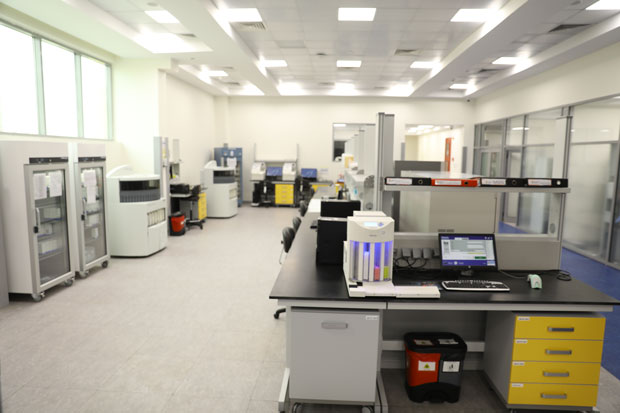Alveolar rhabdomyosarcoma fusion panel

Alveolar rhabdomyosarcoma panel
- Clinical Implications
- Diagnosis of Alveolar Rhabdomyosarcoma
- Two characteristic recurrent chromosomal translocations (80% of cases)
- t(2;13)(q35;q14)
- PAX3 on chromosome 2 and FOXO1 on chromosome 13
- Most common translocation
- t(1;13)(p36;q14)
- PAX7 on chromosome 1 and FOXO1 on chromosome 13
- Test Description
- Test approach
- Reporting name
- Test prerequisites (To ensure timely results)
- Patient’s demographic data.
- Clinicopathologic information:
- Pathology report (final or preliminary) including anatomic location.
- History of any given therapy for cancer and its date and relation to sample sent for molecular study (i.e. pre & post therapy). Therapy includes chemo and radiotherapy, hormonal or targeted therapy.
- Any other relevant clinical data or history.
- Type of sample:
- Preferred: Formalin-fixed, paraffin-embedded (FFPE) tumor tissue block.
- Acceptable:
- Section in Eppendorf: Up to 4 sections, each with a thickness of up to 10 μm and a surface area of up to 250 mm2 + good H&E slide for assessment.
- Five unstained slides + one good H&E slide.
- Specimen Minimum Volume: Two 10-micron sections of FFPE.
- Quality Control measures
- From your side:
- Double check you are fulfilling all required data before sending your sample.
- Check that your pathologist has selected the best block in terms of tumor cellularity, with least presence of necrosis and inflammation.
- Pretherapy sample is preferred (if underwent any cancer therapy).
- In our lab:
- Assessment of tissue for adequacy & tumor cellularity before any molecular analysis.
- Matching block ID with the report ID and demographic data.
- Matching the submitted block with the data reported in the pathology report.
- N.B.
- If the sample sent in Eppendorf, it is your pathology lab’s responsibility to ensure the sample in Eppendorf is corresponding to the submitted H&E slide (we can’t prepare slide from Eppendorf).
- This test does not include a pathology consultation.
- Test Time
- Retention of the sample
- Selected References
- Parham DM et al: Classification of rhabdomyosarcoma and its molecular Skapek SX et al: PAX-FOXO1 fusion status drives unfavorable outcome for children with rhabdomyosarcoma: a children’s oncology group report. Pediatr Blood Cancer. 60(9):1411-7, 2013
- Marshall AD et al: PAX3-FOXO1 and FGFR4 in alveolar rhabdomyosarcoma. Mol Carcinog. 51(10):807-15, 2012
Alveolar Rhabdomyosarcoma: Cellular, malignant neoplasm composed of primitive, monomorphic round cells with evidence of skeletal muscle differentiation.
Real-time PCR for quantitative detection of PAX3/PAX7-FOXO1 gene rearrangement
RNA was isolated and converted into cDNA. TaqMan Gene Expression Assays were used for quantitative polymerase chain reaction (qPCR) analysis of FOXO1-PAX3/7 fusion transcripts. Results interpreted according to the manufacture user guide.
Alveolar rhabdomyosarcoma fusion gene panel.
All samples are subject to stringent quality control measures that include:
From 3 days to 5 working days.
Client provided paraffin blocks & unstained slides (if provided) will be returned after testing is complete.